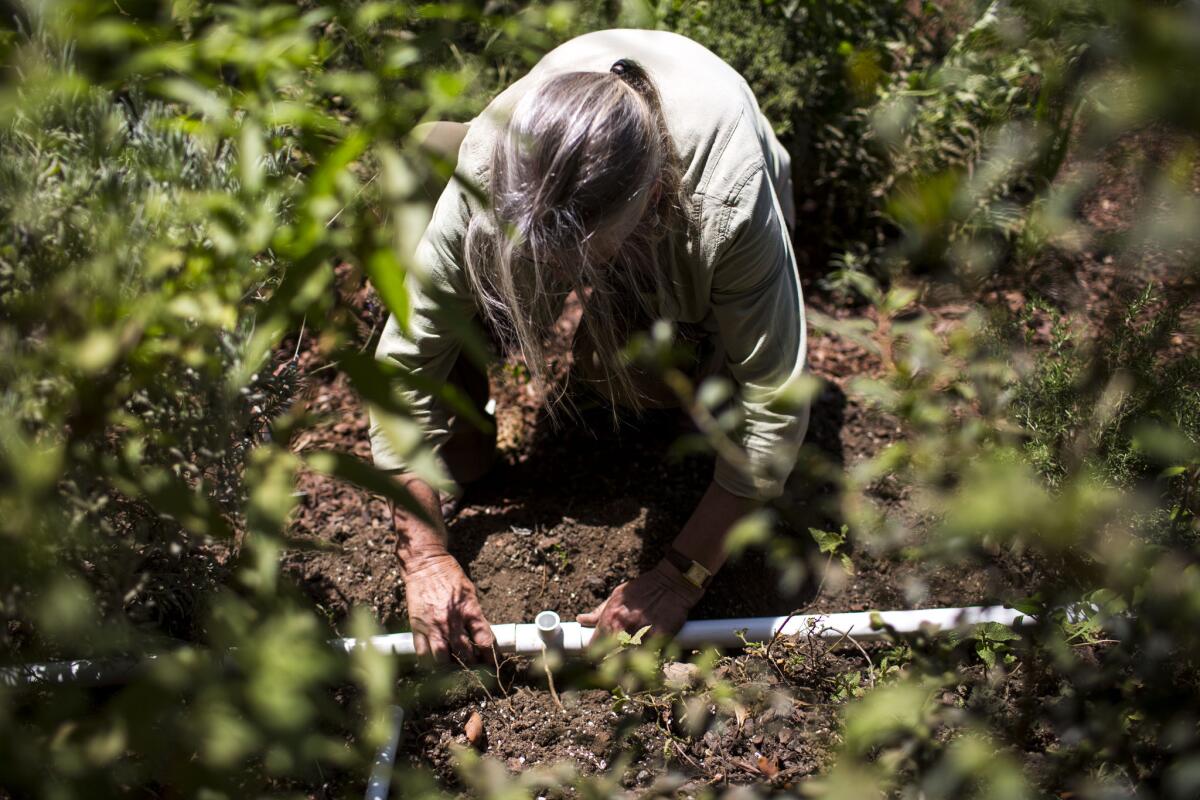Once illegal, watering the garden with drainage from the washer or shower is gaining favor

Annie Costanzo connects two pipes with a T-joint to build a gray water system.
- Share via
Strands of silver hair fell into Annie Costanzo’s face as she wielded a sledgehammer against the brick walkway in her backyard. Plumes of dust and debris filled the air, and reddish-pink shards scattered in the wake of the 64-year-old sculptor’s latest water conservation project.
Over the course of two days, Costanzo created a channel, set PVC pipe in it and drilled a hole in a wall of her house to carry water from her laundry to a mulch basin near a magnolia tree behind her home in the Miracle Mile.
“I’m happy to find any way I can to make water go a little bit further,” she said.
Costanzo is among millions of Californians who, amid the state’s fourth punishing year of drought, are increasingly turning to gray water – from the clothes washer, shower or bathroom sink — to keep trees and other plants hydrated. Educational seminars on the once-illegal water source are filling up faster than ever, installers who did one project a month are putting in two systems a week and a major builder is adding gray water systems to new homes in San Diego. And local and state lawmakers are passing measures and offering proposals to make it easier and cheaper to use gray water.
Still, significant barriers remain. Installing all but the most basic laundry-to-landscape system can require permits and cost thousands of dollars. Experts say the cost savings often don’t pencil out and the short-term water savings are relatively meager, leaving homeowners to wonder whether it’s a worthwhile investment.
“Probably 15 years ago, it was kind of fringe,” said Richard G. Luthy, a Stanford University professor who studies water quality and urban water supply. “Now, it’s part of the portfolio people are looking at for water conservation.”
For years, gray water was not differentiated from toilet water and the law required it to be moved away from the home, said Laura Allen, co-founder of Greywater Action, a collaborative that leads workshops and presentations on gray water.
But over the last quarter-century, nothing has advanced the use of gray water like a good drought.
As the drought of the early 1990s ended, California reclassified gray water as separate from toilet water, something that could theoretically be reused. Water from toilets, kitchen sinks or dishwashers is considered black water, and it can’t be reused.
But the new gray water code “was useless,” Allen said.
“Middle-class homeowners … could not get a permit and do a legal system,” Allen said. “So most people ignored the code and just dumped water wherever they wanted and created rudimentary systems.”
Still, by the late 1990s, studies showed that as many as 1.7 million Californians were using gray water. Allen’s group formed, calling themselves the Greywater Guerrillas because, “There was nothing we did that was legal,” she said.
That changed in 2009, when another drought put lawmakers under pressure to legalize gray water. The state’s plumbing code was revised to allow homeowners to install “laundry-to-landscape” gray water systems without a permit.
And although Californians have been filling up watering cans with gray water for years, installing systems that can divert laundry machine water to outdoor landscapes took off once the plumbing code was revised.
The spike in interest was evident late one recent Wednesday night, when an eclectic group of homeowners, builders and self-proclaimed hippies descended on a Koreatown apartment complex.
They crammed onto worn couches in the lobby to hear Allen’s two-hour gray water crash course. The following Saturday, many of them reconvened for a hands-on installation workshop.
Midway through one of the presentations, one man voiced a common concern.
“This all looks very good, but how much water am I really using for two or three loads of laundry a week?” he said. “Seems like a lot of effort to water three trees.”
Experts say installing an in-home gray water system can sometimes be more trouble than it’s worth. Parts for a laundry-to-landscape system can cost hundreds of dollars, and not everyone is comfortable drilling a hole through their home.
Installing other systems that reuse shower or bath water can require permits both from the city and county, as is the case in Los Angeles. The costs for those projects can escalate into the thousands, and plan review periods can drag on for weeks.
Los Angeles city building officials said they have issued only about 13 permits for gray water systems in the last year. Officials don’t track laundry-to-landscape systems because they don’t require a permit. There are no precise estimates, but gray water advocates believe far more than 1.7 million Californians use gray water in some form.
Gray water’s greatest potential lies in the coming years, experts say. For example, Los Angeles building and safety officials plan to bring a proposal to the city council in coming weeks that would require new buildings to be “gray-water ready.”
“Unless we push this, provide incentive and change the permitting process, I don’t think we have enough incentives out there to implement these systems,” said Newsha Ajami, director of urban water policy with the Water in the West program at Stanford.
A 2009 UCLA report found that if 10% of Southern Californian homes used gray water, “the volume of water saved is equivalent to, or larger than, the capacity of a modern, large seawater desalination plant.”
“It’s not like next year we’re going to see the results,” Ajami said, “but gradually, this could add up and become part of the portfolio – and we have to start investing in it now.”
Some cities have already begun that process. Santa Rosa, Santa Barbara and the Santa Clara Valley Water District offer rebates for laundry-to-landscape materials. In San Francisco, the Public Utilities Commission publishes a gray water manual.
“Many residents have already replaced inefficient toilets, showerheads and clothes washers,” said Amanda Dougherty, the agency’s conservation administrator, “and are looking for that step to using water more efficiently at home.”
Randy Hirt, 47, spent a recent Saturday at Allen’s gray water workshop, soliciting help from an installer.
He’s building a new home in Venice and installing a gray water system.
“We either have to change what we plant or figure out how to use the water more efficiently,” he said. “What other choices do we have?”
[email protected]
Twitter: @ByMattStevens
Times staff writer Taylor Goldenstein and staff photographer Kent Nishimura contributed to this report.







